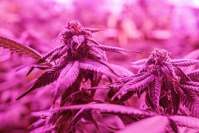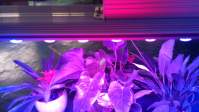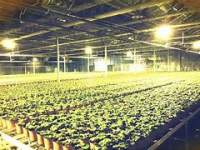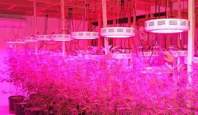The importance of LED plant lights for growing vegetables
Because of the ever-changing climate change and light changes in nature, it is beneficial to growth, especially in the seedling stage. Plants cannot fully absorb the photosynthetic nutrients they need during different growth periods in different growth periods. Plants have to rely on light energy for photosynthesis for growth, flowering and fruiting. People create scientific and reasonable artificial spectrum to produce good absorption and reflection conditions for plant growth. The energy values of the blue light zone and the red light zone are very similar to the efficiency curve of plant photosynthesis, which is the best light source for plant growth. Aiming at the research on plant photosynthesis and the research and development of agricultural LED plant lamps, the company has created a professional plant planting laboratory to carry out scientific research on vegetables, fruits, medicinal materials and other plants, so as to target different plants and affect seedling and plant growth. The scientific research results of precise supplementary light application of plants in terms of light quality, wavelength and other aspects.
For more than ten years. The light environment control lighting technology for plant growth has attracted attention. Lighting technology is mainly used in two aspects:
1. When the amount of sunshine is small and the sunshine time is short, it can be used as supplementary lighting for plant photosynthesis;
2. As the induced lighting for plant photoperiod and light morphology. If LED plant lights are used to supplement lighting and hydroponic systems, air can be recycled, excess heat and water can be removed, and electrical energy can be efficiently converted into effective photosynthetic radiation, which will eventually be converted into plant matter. The research indicates that the use of LED lighting can increase the growth rate and photosynthetic rate of lettuce by more than 20%. The research that uses LED plant lights to the factory can be carried out and found that compared with fluorescent lights, the light source of the LED plant light wavelength can significantly promote The growth and development of spinach, radish and lettuce improve the morphological index. Compared with metal halide lamps, the anatomical morphology of the stems and leaves of the pepper and perilla plants grown under the LED plant lamp with the corresponding wavelength changes significantly. Any plant needs sunlight to grow and increase with the light density. , The photosynthetic rate of the plant is increased.
LED plant lights are one of the important physical environmental factors that are indispensable to promote plant growth and development. Through the adjustment of light quality, controlling plant morphology is a particularly important technology in the field of facility cultivation. The LED used in the field of plant cultivation can also express the following characteristics: rich wavelength types, just in line with the spectral range of plant photosynthesis and light morphology; the half-width of the spectral wave width is narrow, which can be combined according to needs to obtain authentic monochromatic light and composite spectra, It can concentrate light of a specific wavelength to irradiate crops evenly; it can not only adjust the flowering and fruiting of crops, but also control the height of the plant and the nutrient content of the plant; the system generates less heat and takes up less space, and can be used for multi-layer cultivation and three-dimensional combination The system achieves very low thermal load and miniaturization of production space; its strong durability will also reduce operating costs.
The use of LED plant lights is coordinated with the light saturation point and light compensation point of different plants. The light saturation point and light compensation point of plants vary with crop types and cultivation conditions. If plants are growing due to lack of sunlight in the environment, such as planting in basements and balconies. Artificial light is needed to replace sunlight to provide the energy required for photosynthesis for plant growth, and the light intensity of the required light source must reach the light compensation point required by the plant to grow normally.
Below the light compensation point, the plants grow excessively or grow slowly; above the light saturation point, the photosynthetic rate no longer increases, resulting in a phenomenon of photoinhibition, resulting in a waste of light energy. The light intensity is between the light saturation point and the light compensation point. The use of LED plant lights to grow fruits and vegetables can promote plant photosynthesis, shorten the growth cycle, increase yield by 20-80%, promote flowering, promote fruit, and increase fruit setting. Deworming and disease resistance, reducing deformed fruits, improving the taste, sweetness, quality and appearance of fruits. This is why the use of plant growth lights has no effect. If the temperature, humidity, water, fertilizer, and carbon dioxide concentration are normal, the biggest reason is that the intensity of the light emitted by the LED plant lights is lower than the light compensation point of the plant.
There are two reasons for low light intensity:
1. The luminous intensity of the LED plant lamp itself is low, the solution is to replace the lamp, or increase the lamp
2. The LED plant light has high luminous intensity, but the distance between the lamp and the plant is too high, so that the light intensity can reach the light compensation point of the plant when the leaf surface is lower. The solution is to reduce the height of the lamp.
The intensity of photosynthesis of any kind of crop is closely related to the intensity of light. The tendency of photosynthetic intensity to change with the intensity of light is similar, the increase of light, the increase of photosynthesis, the weakening of light, the decrease of photosynthesis. But when the light is increased to a certain degree, the photosynthetic intensity will no longer increase, and the light intensity at this time is the light saturation point of photosynthesis. When the light weakens to a certain limit, the photosynthetic intensity cannot be measured (the photosynthetic intensity and the respiratory intensity are exactly equal, the ratio is 1), and the light intensity at this time is called the photosynthetic light compensation point.
Because of these remarkable characteristics, LED plant lights are very suitable for plant cultivation in controlled facility environments, such as indoor flowers and facility gardening, factory seedlings and aerospace ecological life support systems.






